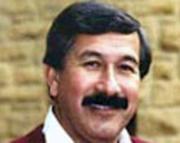Historian reflects on a changed Compton
Listen to the full audio story
- compton_web.mp3

When Stanford Professor Al Camarillo asks people if they know about Compton he usually gets a response filled with stereotypes.
"Everybody knows about Compton. I say 'what do you know about Compton?' It's a black ghetto. Gangsta Rap. The Crips and the Bloods. Alright those are realities but they are not the reality," said Camarillo.
For the past few years, Camarillo has been writing a book about the city to reveal a more nuanced picture-- one that shows the city grapples with racial divides but also has very real hopes.
He's starting his journey by taking a look at his own family's experience in the city. His father moved to Compton in 1914, and Camarillo grew up in a Mexican American barrio in the city in 50s and 60s. He says his life growing up was intertwined with Compton becoming black.
"By the time I’m in middle school...Realtors are trying to make their last stand, saying African Americans are not going to be allowed to cross the Alameda corridor and of course that didn't work after 1965 when the watts riots blew the lid off," said Camarillo.
When integration hit his high school, he found himself in a unique position. He went to school and was friends with the black student being bussed to his white high school. Because he knew both the black and white students, administrators asked Camarillo to help mediate racial tensions. But, he says, the meetings over cookies didn't help ease the divide.
"There was enormous reaction to the black kids coming to campus. There were fights and graffiti, saying go back to the west. I mean it was really bad," he said.
In today's Compton, the white community virtually doesn't exist. While blacks are still heavily influential in the community, the majority ethnic group is now Latino. In the 2000 Latinos outnumbers blacks in the community, and the 2011 census shows even greater number of Latinos.
For his book, Camarillo gathered about 100 oral histories from residents from different ethnic groups and generations. He said the interviews with older black residents show that their perception of the community doesn't mirrors the stereotype embedded in popular culture.
"[for blacks] to break into a white community was an enormous achievement. They speak of it like Nirvana. Compton is nirvana," said Camarillo. "You have appreciate the nature of the oppression that blacks suffered to understand those comments."
When he interviewed immigrant Latinos, Camarillo found they also moved to the city for a chance to buy an affordable home and build a family. Those are goals that transcend race or generation, says Camarillo.
"The reality of Compton is it's populated by African American and Latino families that are trying to make the best of what they have. . .They are trying to make life livable amidst a poor population... so that's a fundamental human experience for people in Compton, whether it's 60 years ago, 100 years ago or today.
Camarillo's book is tentatively titled, "Going Back to Compton: Reflections of a native son on an infamous American city." He says it should be done in about two years.
Check out the future home of Annenberg student media:

Wallis Annenberg Hall
(opening Fall 2014)

